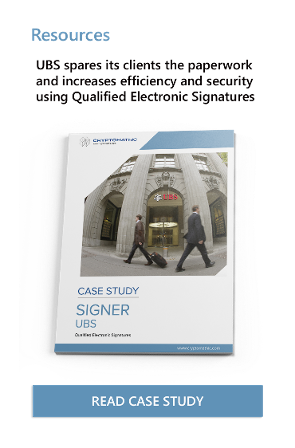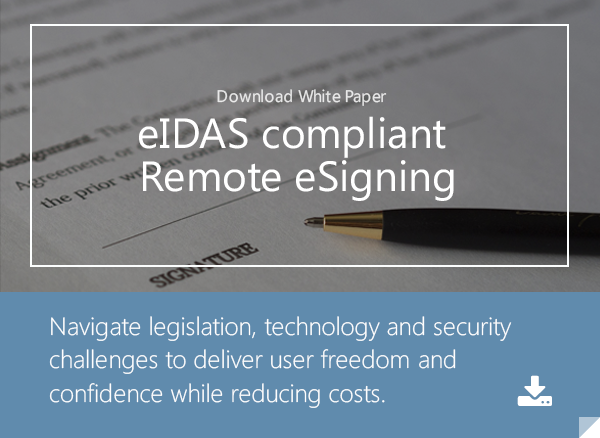
- Home >
- Bridging eIDAS & Anti-Money Laundering Directives
Banks and other financial institutions are playing a key role in countering global challenges like money laundering and terror financing.
Most international banks spend significant time and resources to ensure that they are doing everything that they possibly can to prevent misuse of the services that they provide. The checks that they perform meet and often exceed the regulations imposed on them by regulators.
No one in the banking industry would deny the importance of these checks and safeguards, but at the same time it is important to ensure that these checks do not affect the kind of service that customers have come to expect in the digital age. Customers can get almost anything online these days, without the need for any physical paper documentation. The European Commission's latest efforts to combat money laundering in the digital age have come in the form of amendments to the 4AMLD - short for the 4th Anti-Money Laundering Directive.
In a recent article, Andrea Servida who is the head of the "eGovernment and Trust" unit at DG CONNECT at the European Commission, summarized some of the key motivators and the expected impact of the 4AMLD amendments on the broader eIDAS initiative. Mr Servida highlights that the amendments introduce "the possibility of identifying the customer and verifying the customer's identity on the basis of documents, data or information obtained from a reliable and independent source, including, where available, electronic identification means as set out in the eIDAS Regulation". This undoubtedly creates synergy between 4AMLD and the broader eIDAS directives, allowing for the use of notified eID schemes as a means to ensure compliance with AML directives.
Another significant change is the modification of the reference to "original documents or copies" in the 4AMLD. As per the latest amendment, electronic documents would also qualify as valid documents to perform these checks. This would likely prove to be a significant time saver for banks as well as customers. It will not only make it easier and faster to complete Know Your Customer (KYC) and related checks, but is likely to improve the quality of these checks as well, by allowing for a near complete digital approach.
The last major amendment revolves around cross border validity of e-Identification. This would be a boon for both banks and customers as it would make it easier to sell financial products across national borders within the European Single Market and customers would have the ability to pick from a wider selection of products.
The amendments also address concerns related to virtual currencies, define enhanced customer due diligence steps, and encourage cooperation between competent authorities of the member states on various issues. The changes are based on the impact assessment of the earlier guidelines and they definitely go a long way in making the 4AMLD guidelines more relevant in an ever changing world. It is indeed commendable how the European Commission is adapting rapidly to the ever changing threat of money laundering and terror funding, while at the same time making it easier for banks and their customers to transact online.
References and Further Reading
-
eIDAS & 4th Anti-Money Laundering Directive - a short update (2017), by Andrea Servida
-
Directive (EU) 2015/849 on the prevention of the use of the financial system for the purposes of money laundering or terrorist financing (2015), by the European Parliament and the Council of the European Union
- Proposal for a DIRECTIVE OF THE EUROPEAN PARLIAMENT AND OF THE COUNCIL amending Directive (EU) 2015/849 on the prevention of the use of the financial system for the purposes of money laundering or terrorist financing (2016), by the European Commission
- Selected articles on Authentication (2014-16), by Heather Walker, Luis Balbas, Guillaume Forget, Jan Kjaersgaard, Dawn M. Turner and more
- Selected articles on Electronic Signing and Digital Signatures (2014-16), by Ashiq JA, Guillaume Forget, Jan Kjaersgaard , Peter Landrock, Torben Pedersen, Dawn M. Turner, Tricia Wittig and more
- REGULATION (EU) No 910/2014 on electronic identification and trust services for electronic transactions in the internal market and repealing Directive 1999/93/EC (2014) by the European Parliament and the European Commission
- Recommendations for the Security of Internet Payments (Final Version) (2013), by the European Central Bank
- Draft NIST Special Publication 800-63-3: Digital Authentication Guideline (2016), by the National Institute of Standards and Technology, USA.
- NIST Special Publication 800-63-2: Electronic Authentication Guideline (2013), by the National Institute of Standards and Technology, USA.
- Security Controls Related to Internat Banking Services (2016), Hong Kong Monetary Authority
Image: Money Laundering - EUROS, courtesy of Images Money, Flickr (CC BY 2.0)

